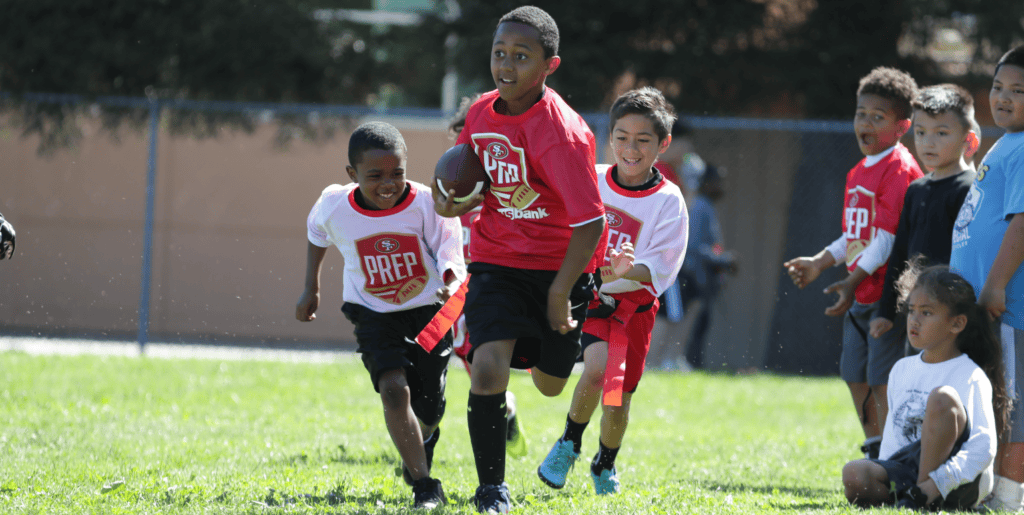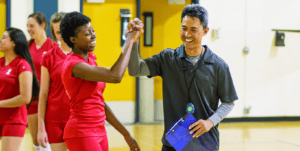PCA Resource zone
Tricks of the Trade

Unintended chaos at practice usually occurs during the brief moments between activities. These Tricks of the Trade can help you run practices more smoothly. Identify the strategies you are most comfortable using, introduce them into your practices, and then return to them over and over again throughout the season. We also encourage you to work with your players to come up with your own tricks of the trade! With these strategies, you’ll run practices that flow better while minimizing disruptions and behavior issues.
To remember the Tricks of the Trade strategies, all you have to do is play a game of T-A-G (Transitions, Attention Getters, Grouping Strategies.
Transitions
These examples will move a group from one location or activity to the next with minimal chaos.
- “Monica is the head of the dragon, and Justin is the tail. Everyone else is in the body of the dragon. When I yell “Dragon!” form the dragon as quickly as possible … “Dragon!” (with older youth, say “Monica is the front of the line and Justin is the back of the line, everyone else line up between Monica and Justin.”)
- “Bump your volleyball to your partner two more times, then join me in a circle. You have ten seconds … nine…eight…”
- As you are moving from one area to another (down the hallway, from a circle to the baseball diamond, etc.) you call, “1+1 is …” and they respond, “2!” You call, “2+2 is …” and they respond, “4!” “4+4 is…”
- As students are coming together, give them two choices from which they yell out their preference. Keep naming choices until everyone is rounded up. “What do you prefer, summer or winter?” “What team do you prefer, Real Madrid or Barcelona?” “What do you prefer, strawberries or blueberries?”
Attention Getters
These are examples to capture players’ attention, begin or end
activities, and transition between activities.
- “Form a circle in 5 (clap, clap) … 4 (clap, clap) … 3 (clap, clap) … 2 (clap, clap) … 1 (clap, clap).”
- “If you can hear my voice, clap once. If you can hear my voice, clap twice. If you can hear my voice, clap three times.”
- “Aaaaaaaaaaaaaaaaaand FREEZE!”
- Call and response rhythm clap: Coach creates a rhythm clap, and players clap the rhythm back
- “If you hear my voice, touch your head. If you hear my voice, touch your knee. If you hear my voice, touch your shoulders.”
- “How many fingers do I have up?” (Briefly hold up several fingers.) “How many fingers do I have up?” (Briefly hold up a different number of fingers. Continue until you have their attention.)
- Coach says “1, 2, 3 Eyes on Me!” Players say “1, 2 Eyes on You!”
Grouping Strategies
Creative tricks will help get youth into different groupings (one group, two teams, multiple smaller groups, or pairs).
To Get Into One Large Group:
- “Circle up in 5, 4, 3, 2, 1 … “
To Break Into Smaller Groups:
- “If you were born in January, February or March line up at the red cone. If you were born in April, May or June line up at the yellow one … “
- “Get into pairs, get into groups of five, get into groups of eight, get into groups of three … ” (Keep going until you get players into the number of teams you want or until they are grouped into the right number.)
- Count off players by assigning them “Football, Tennis, Baseball; Football, Tennis, Baseball…” Then, have players stand with those teammates who have the same sport. In this example, you will have three groups.
To Break the Group Into Two Teams:
- “Apple, orange, apple, orange, apple, orange, etc … All apples make a circle over here. All oranges make a circle over there.”
To Get Everyone Into Pairs:
- Lizard, frog, lizard, frog, etc … Now, every lizard find a frog.”
Role of a Coach in Grouping Players
Left to their own devices, youth will group in one of two ways:
- They will scramble to get the ‘best’ players on their team, leaving some to feel incredibly self-conscious about their skill level.
- They will group with their friends, again leaving some out and creating divisions in the team.
Grouping strategies play a big role in minimizing these patterns and ensure everyone is fully and equally involved. It is the role of a coach to create an emotionally safe space by always using grouping strategies to divide players up.
Be sure to mix up how you count off groups so youth at the far end of the line don’t rearrange themselves to control what team they are on (e.g., yellow, orange, blue, blue, yellow, orange).
Grouping strategies play a big role in minimizing these patterns and ensure everyone is fully and equally involved. It is the role of a coach to create an emotionally safe space by always using grouping strategies to divide players up.







